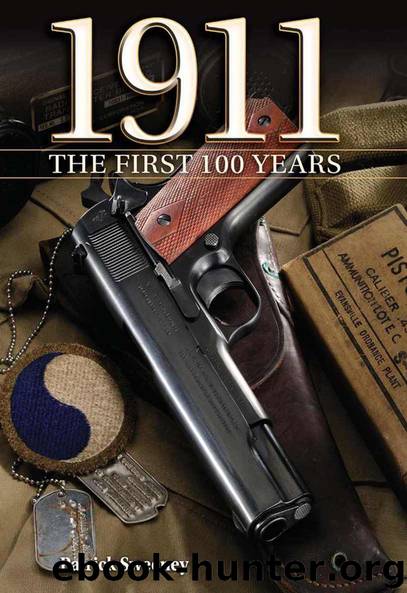1911 The First 100 Years: The First 100 Years by Patrick Sweeney

Author:Patrick Sweeney [Sweeney, Patrick]
Language: eng
Format: epub
Tags: epub, ebook
Publisher: F+W Media, Inc.
Published: 2010-08-27T05:00:00+00:00
Today you can have a Dillon (or other brand) progressive reloader with case feeder, bullet feeder, and produce buckets of practice ammo. No need to slave in the basement all week for an hour's practice on the weekend.
A thousand rounds a month meant 12,000 rounds of practice and competition a year. A progressive press meant a tenth of the time spent in the basement doing nothing but loading, time that could be spent in shooting, draw and dry-fire practice, and analyzing practice sessions. And more was even better. Now, Brian and Robbie were not alone in having the ammo advantage. The gunsmith who taught me a lot, Dan McDonald, had one of the fabled Star machines to load on, and he even had the parts necessary to convert it back and forth from .38 Special to .45 ACP. He did not lack for practice ammo.
To give you an idea of what this meant, in terms of ammo and practice, the late Skeeter Skelton did an article in the 1970s on barrel longevity. He prevailed on the ammo companies to send him a total of 15,000 rounds of .45 ACP and Colt to send a brand-new Gold Cup. It took Skeeter and friends months to shoot up “all that ammo” (which, to be fair, really is a lot of ammo). To no great surprise, the Gold Cup shot as accurately afterwards as it had from the beginning. He even sacrificed the barrel, sectioning it to observe the wear, of which there was practically none. By the first years of the 1980s, the top shooters were doing 12,000 rounds a year and more. Heck, by the late 1980s, even I was shooting more than double that annually.
The reloading press scene was littered with the frames of the contenders: RCBS made a linear press in which the rounds shuttled along in a straight line, instead of circling the press axis; RDP made a press that was so heavily-built it threatened to crush a standard workbench; and there were others. But the winner back then was Dillon. The first high-volume, affordable press was the 450. That came out in 1982, and while it was only semi-progressive (you had to manually index the plate and press bars to drop powder and shuttle primers in) it was blazing fast compared to a single-stage press. And dirt-cheap compared to a Star. In 1985 Dillon came out with the 550, and that was the ticket. It automatically dispensed powder, fed primers, and all you had to do was flick the shell plate a quarter-turn between handle pulls and insert a fresh empty case. You could change calibers in ten minutes, and a conversion setup cost practically nothing.
Suddenly, everyman could load as much ammo as he could shoot. Well, the real limitation was cost and time: as in, how much ammo can you afford to buy as bullets, primers and powder, and how much time can you spend loading and shooting? A reasonable net output on a Dillon 550B (or a current competitive press such as a Hornady Lock 'N Load) is 400 rounds an hour.
Download
This site does not store any files on its server. We only index and link to content provided by other sites. Please contact the content providers to delete copyright contents if any and email us, we'll remove relevant links or contents immediately.
| Ammo & Grenades | Firearms |
| Swords & Knives |
How to Be a Bawse: A Guide to Conquering Life by Lilly Singh(7360)
Spare by Prince Harry The Duke of Sussex(5054)
Millionaire: The Philanderer, Gambler, and Duelist Who Invented Modern Finance by Janet Gleeson(4352)
Machine Learning at Scale with H2O by Gregory Keys | David Whiting(4108)
Never by Ken Follett(3762)
Harry Potter 02 & The Chamber Of Secrets (Illustrated) by J.K. Rowling(3613)
The Heroin Diaries by Nikki Sixx(3480)
Urban Outlaw by Magnus Walker(3322)
Harry Potter and the Prisoner of Azkaban (Book 3) by J. K. Rowling(3293)
Fairy Tale by Stephen King(3193)
Japanese Design by Patricia J. Graham(3097)
The Man Who Died Twice by Richard Osman(2979)
The Club by A.L. Brooks(2852)
Stacked Decks by The Rotenberg Collection(2796)
Will by Will Smith(2770)
Harry Potter and the Deathly Hallows (7) by J.K. Rowling(2629)
Churchill by Paul Johnson(2493)
The Chimp Paradox by Peters Dr Steve(2279)
Borders by unknow(2214)
